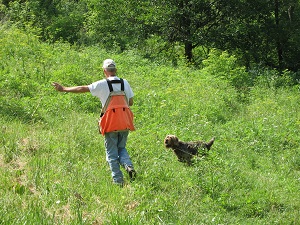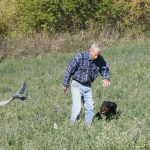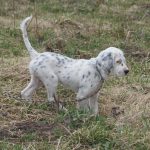POINTING DOG POINTERS: Problems in Developing the Started Dog – Handling and Control
By Bob and Jody Iler
“My pup just doesn’t pay attention to me in the field! It’s almost as if he’s gone deaf on me!”
“Lately my pup has been hanging close to me and doesn’t want to get out and hunt.”
“I’m hunting with a buddy and his dog and my pup constantly tailgates his dog.”
“My pup is taking off and hunting by himself.”
If you find yourself voicing one of the above comments during your pup’s first season – or something similar – don’t be discouraged. Issues with handling and control pop up regularly with a young started dog. There’s a fine line between letting the young inexperienced dog have his head to build his confidence and trying to instill some control so that he’ll learn to hunt as your partner.
The first season is a time of mistakes and successes, trial and error, and growth and development for your pup. Some of these mistakes are unavoidable, but what you do as owner, handler, and trainer can help prevent problems. Genetics and hunting grounds also play a role. You may have a pointing dog with field trial bloodlines, one that will start to stretch out and expand his range as he grows. You may have a “boot polisher” pup that doesn’t range out as far as you’d like. Hunting in large open areas or tight undergrowth and woods will affect a pup’s range and also your ability to handle him.
Let’s take a look at two issues that can also affect your control training – underhandling and overhandling.
Underhandling
One year we had a talented wirehair pup, Giddy, that sailed through her started dog training and put on a great show for her owner each time he visited. She was birdy, animated, full of drive and hunt. She pointed like a champ and retrieved to hand. She was a natural. Her young owner was pleased and excited about the upcoming season. The end of her training just happened to coincide with the opening of the Iowa bird season in just a few days. We reminded her owner that, after three months with us, Giddy needed some time to bond again with him. They needed time to practice yard and field training together. We strongly advised against taking Giddy out on opening weekend. And we were adamant about initially hunting Giddy alone, without other hunters and dogs.
The following January we got a call from Giddy’s owner. He was having handling troubles with her. “What kind?” we asked. He said she was self-hunting and paying no attention to his whistle or commands. “How long has this been going on?” we asked. Sheepishly, he told us he’d taken Giddy out on opening day in October with friends and other dogs. He’d continued hunting her like this for the season. Within no time he had lost control of her. “Why didn’t you call us sooner?” we asked. He was reluctant to, he said, because he’d disregarded our advice. He brought Giddy back to us for a month, so we could go back to the basics in handling and control work with her. Then he worked with us and Giddy as well. Most important, he took her home and kept a good thing going.
Underhandling can take a lot of forms, but usually occurs when we don’t take the time or make the effort to keep the handling training going in the first season. This means bonding with your pup. It means hunting alone for a while with just you and your pup, until the two of you learn your own rhythm. It means not hunting with one or more other hunters and dogs, where you’ll be unable to handle your own dog properly. This scenario teaches your pup to ignore you and “run with the other guys” – instilling habits that may be tough to break, and also leading to other hunters’ possible resentments and even dogfights.
Overhandling
One year, early in bird season, we got a call from an older man whose young dog, Sadie, wasn’t hunting. “She walks with me in the field and won’t range out,” he said. Though he had trained her himself on birds and she had initially been enthusiastic, hunting and pointing birds, now he couldn’t get her to do much of anything in the field. When he brought Sadie to us, we took her out for an evaluation as her owner handled her. As he waved his arm to guide her direction and whistled and called to encourage her, Sadie seemed reluctant to be in the field and extremely unsure of herself.
Her owner explained that he had read everything he could find on pointing dog training, in addition to watching bird dog videos. Not only did he research many methods of developing a pointing dog, he also tried all these methods on Sadie, a pup just shy of a year old. He’d also experimented with the e-collar on her. He was a well-meaning, earnest man who loved his dog and thought he was doing everything he could to bring Sadie along. But in fact, he had overhandled Sadie. He had used the checkcord, his voice, the whistle, the e-collar, and many different methods of training, in no logical sequence. He’d also jumped ahead and tried to steady Sadie to wing and shot – college-level work reserved for an experienced, mature dog – not a started dog. All of this confused Sadie and caused her to have unpleasant associations with birds and hunting. All the fun had been taken out of her development. Like a child with too much pressure put on her, Sadie had shut down. She needed a return to age-appropriate basics of training, guided by simplicity and fun.
Overhandling can often take the starch out of a promising pup and cause him to hang close and even quit hunting. A young novice trainer might lean on the whistle way too much – giving constant directions and commands that may confuse a young pup. No matter how much we think we know where the birds are, our pups have been blessed with a much better nose than ours – let them do their job and find the birds without constant interference. If we are always on the dog to stay close to us, we may keep them underfoot and unable to do what they’re bred to do – get out there and find and point the birds!
And though using an e-collar is not part of our started dog program, there are some owners who may decide that their “disobedient” pups need a bit of extra “reinforcement” with an e-collar. This can often result in a pup that quits hunting entirely if he has received stimulation in connection with bird work. There is a place for the e-collar in training with some dogs, or with certain types of advanced training. There’s no place for the e-collar in a young pup’s first season. And, we might add, use of the e-collar requires a person who is properly trained to use it. It takes a lot of time, patience and positive bird experience to make up for damage done by an e-collar improperly used.
If we have to err on the side of anything in the first season, it would be on the side of letting your pup have less control and more fun and experience in his first days afield, rather than hacking him in and trying to instill too much control at this impressionable age. It will be up to you to find that fine line between keeping pup’s enthusiasm fired up and also teaching him to hunt with and for you. We’ve talked about handling training in the May PDP column – this is a good guide to review if you need to go back to the basics. And don’t forget – the best resource you’ll have during this challenging time is your checkcord! Don’t be afraid to use it both in your continued training sessions and in the field.
Pointing Dog Pointers features monthly training tips by Bob and Jody Iler, who own Green Valley Kennels in Dubuque, Iowa. Bob and Jody have trained pointing dogs for over 35 years and have written many articles for Pointing Dog Journal.









